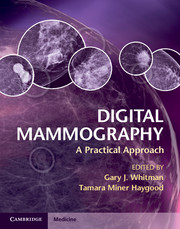Book contents
- Frontmatter
- Contents
- List of contributors
- Preface
- Acknowledgments
- Chapter 1 Detectors for digital mammography
- Chapter 2 Image acquisition
- Chapter 3 Preparing digital mammography images for interpretation
- Chapter 4 Image display and visualization in digital mammography
- Chapter 5 PACS, storage, and archiving
- Chapter 6 Interpretation of digital screening mammography
- Chapter 7 Efficacy of digital screening mammography
- Chapter 8 Artifacts in digital mammography
- Chapter 9 Mobile digital mammography
- Chapter 10 Procedures with digital mammography
- Chapter 11 Digital breast tomosynthesis
- Chapter 12 Breast computed tomography
- Chapter 13 Cases
- Chapter 14 Comparison of commercially available systems
- Index
- References
Chapter 11 - Digital breast tomosynthesis
Published online by Cambridge University Press: 05 December 2012
- Frontmatter
- Contents
- List of contributors
- Preface
- Acknowledgments
- Chapter 1 Detectors for digital mammography
- Chapter 2 Image acquisition
- Chapter 3 Preparing digital mammography images for interpretation
- Chapter 4 Image display and visualization in digital mammography
- Chapter 5 PACS, storage, and archiving
- Chapter 6 Interpretation of digital screening mammography
- Chapter 7 Efficacy of digital screening mammography
- Chapter 8 Artifacts in digital mammography
- Chapter 9 Mobile digital mammography
- Chapter 10 Procedures with digital mammography
- Chapter 11 Digital breast tomosynthesis
- Chapter 12 Breast computed tomography
- Chapter 13 Cases
- Chapter 14 Comparison of commercially available systems
- Index
- References
Summary
Introduction
Digital breast tomosynthesis is a breast imaging technology that provides three-dimensional-like information. Tomosynthesis has been developed to improve the characterization of breast lesions and cancer detection, particularly in dense breasts. However, an understanding of mammography and its limitations is necessary to fully appreciate tomosynthesis and its potential uses and advantages. The purpose of mammography is the early detection of breast cancer. Mammography is the only imaging method scientifically proven with the ability to detect clinically occult breast cancer and result in a decreased mortality rate from breast cancer. Several large controlled trials have demonstrated the efficacy of screening mammography, reducing breast cancer mortality rates by 18–30% [1,2]. However, screening mammography does not detect all breast cancers. Film-screen mammography does not detect 10–20% of palpable breast cancers, particularly in dense breasts, as there may not be a sufficient difference in contrast between the normal breast tissue and the cancer [3,4].
Film-screen mammography is an analog detection system, in which x-ray photons pass through the breast and are converted to light by a fluorescing screen. A reaction on the film emulsion is triggered by the light. The film is developed by a chemical process, thus producing a gray-scale image of the photon distribution. Digital mammography differs from film-screen mammography in that the x-ray photons strike a digital detector, which converts the absorbed energy into an electronic signal. This signal is received, processed, and stored as a matrix. The signal is linearly proportional to the intensity of the transmitted x-ray. This results in a wider dynamic range than for film-screen mammography [5]. Digital mammography provides a broader dynamic range of densities and greater contrast resolution. However, the spatial resolution of film-screen mammography is better than that of digital mammography. Spatial resolution is measured in terms of the smallest high-contrast object that can be distinguished as distinct. Film-screen mammography resolves 12 and 15 line-pairs/mm, which is equivalent to 42–30 μm pixels. For digital mammography, spatial resolution ranges from 100 to about 50 μm pixels in whole-breast mode or 5–10 line-pairs/mm [6]. Because of reduction in quantum mottle and elimination of granular artifacts from film emulsion, digital images have lower noise than film-screen images [5,7]. The radiation dose of film-screen and digital mammography is comparable, with average mean glandular doses of 4.7 and 3.7 mGy for film-screen and digital mammography, respectively [8,9].
- Type
- Chapter
- Information
- Digital MammographyA Practical Approach, pp. 109 - 124Publisher: Cambridge University PressPrint publication year: 2012
References
- 2
- Cited by



